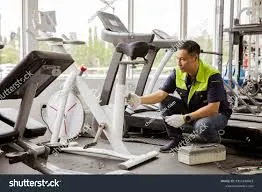Gym equipment is a significant investment, whether in a commercial fitness center or a home gym. Proper maintenance and timely repairs can extend the lifespan of your machines, ensuring they function efficiently and safely. Neglecting minor issues can lead to costly replacements and potential safety hazards. In this guide, we’ll cover essential tips for keeping your gym equipment repair in top condition.
1. Regular Inspection and Maintenance
Routine inspections are crucial for identifying early signs of wear and tear. Establish a maintenance schedule to prevent minor issues from escalating into major problems.
Checklist for Regular Inspections:
- Bolts and Fasteners: Check for loose screws and tighten them as needed.
- Cables and Pulleys: Look for frayed or worn-out cables and replace them immediately.
- Belts and Chains: Inspect treadmill belts and bike chains for signs of wear.
- Lubrication: Ensure all moving parts are adequately lubricated.
- Electronic Components: Test digital screens and buttons for functionality.
- Noise Check: Listen for unusual noises that may indicate internal damage.
2. Cleaning and Sanitization
Sweat, dust, and dirt can accumulate on gym equipment, leading to malfunctions and hygiene concerns. Regular cleaning prevents buildup and extends the lifespan of your machines.
Cleaning Tips:
- Use Non-Abrasive Cleaners: Avoid harsh chemicals that may damage surfaces.
- Wipe Down After Use: Encourage users to wipe equipment with disinfectant wipes.
- Deep Clean Weekly: Use a damp cloth and mild soap to clean surfaces thoroughly.
- Vacuum Treadmills: Dust and debris can accumulate under the belt, affecting performance.
3. Lubrication and Belt Adjustments
Lubrication reduces friction and prevents excessive wear on moving parts. Treadmills, elliptical machines, and weight machines require periodic lubrication to function smoothly.
How to Lubricate Gym Equipment:
- Treadmills: Apply silicone-based lubricant under the belt as per the manufacturer’s instructions.
- Ellipticals and Bikes: Lubricate joints and pedals to minimize noise and friction.
- Strength Machines: Ensure guide rods and weight stacks are well-lubricated.
4. Handling Common Repairs
Even with proper maintenance, gym equipment can develop issues over time. Knowing how to fix minor problems can save time and money.
Common Issues and Solutions:
- Treadmill Belt Slipping: Tighten or replace the belt if it becomes loose.
- Elliptical Resistance Issues: Check for faulty sensors or loose connections.
- Stationary Bike Pedal Loosening: Tighten the pedal and inspect the crank arm.
- Weight Machine Cable Damage: Replace frayed or broken cables promptly.
5. Knowing When to Call a Professional
While DIY repairs can solve minor issues, some problems require professional expertise. If your equipment experiences electrical failures, motor issues, or structural damage, hiring a certified technician is the best course of action.
When to Seek Professional Repair:
- Unresponsive Digital Console: If resetting doesn’t fix the issue, a technician may need to replace internal components.
- Motor Malfunctions: Unusual burning smells or failure to start indicate motor damage.
- Frame or Structural Damage: Cracks or bends in the frame can compromise safety.
- Recurring Issues: If the same problem keeps occurring, professional repair can prevent long-term damage.
6. Investing in Quality Replacement Parts
Using original equipment manufacturer (OEM) parts ensures compatibility and longevity. While cheaper alternatives may be tempting, they can compromise performance and safety.
Where to Find Quality Parts:
- Manufacturer Websites: Direct purchase from brands ensures authenticity.
- Certified Dealers: Authorized dealers provide reliable replacement parts.
- Specialized Repair Shops: Many local shops stock high-quality gym equipment parts.
7. Preventive Maintenance Plan
Creating a preventive maintenance plan helps avoid unexpected breakdowns. Schedule monthly, quarterly, and annual maintenance checks to keep your equipment in peak condition.
Sample Maintenance Plan:
- Daily: Wipe down surfaces and inspect for visible damage.
- Weekly: Check lubrication levels and inspect moving parts.
- Monthly: Tighten bolts, inspect cables, and calibrate digital consoles.
- Quarterly: Perform deep cleaning and replace minor worn-out parts.
- Annually: Schedule a professional inspection for a comprehensive check-up.
Conclusion
Proper gym equipment repair and maintenance not only extend the lifespan of your machines but also ensure a safe and enjoyable workout experience. Regular inspections, cleaning, lubrication, and timely repairs prevent costly replacements and keep your fitness center running smoothly. By following these essential tips, you can maintain your gym equipment in top condition and maximize its efficiency for years to come.

